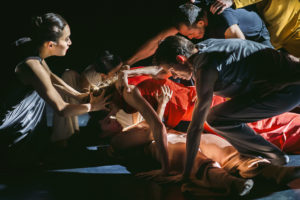Nederlands Dans Theater: Goecke, León/Lightfoot, Pite / Mixed Bill - Vancouver Ballet Society
- Home
- Reviews 2014 - 2019
- Nederlands Dans Theater: Goecke, León/Lightfoot, Pite / Mixed Bill

Nederlands Dans Theater’s latest mixed bill, Savoir Faire, was shown in its temporary home, the Zuiderstrand theatre on the outskirts of The Hague, in May (while its permanent base, the Lucent theatre, undergoes renovation). With works by Crystal Pite, Marco Goecke and the duo Leon/Lightfoot performed by the amazingly expressive NDT dancers, the sum of the parts can only be described as a blast of theatrical genius.
Spanish-born Sol León and Brit Paul Lightfoot (he is artistic director of NDT) have been creating in tandem since 1989 and have been NDT’s house choreographers since 2002. Shut Eye, the evening’s opener, which premiered in The Hague in 2016, has all the elements of their abstract and poetical approach. Their contrasting styles complement each other — his classicism tweaked by her quirky individuality.
On this occasion, Ólafur Arnalds’ darkly minimal music blends with the monochromatic black-and-white palette of the set to surreal effect. The entire backdrop is a vast screen peopled by two giant figures, blurred shadows that are either reflections of the action taking place onstage or else preoccupied in a mysterious dialogue of their own.
Through an upstage door, the players emerge. Central to the action is muscular, grizzled Jorge Nozal, who initially appears contemplative, lost in thought. When Nozal is joined by tiny Meng-Ke Wu (both clad in sombre black), their duet has a strange frantic vibe, while that of the second couple (in ordinary dress) begins on an anxious note, with its weave of hyper-extended limbs and fluid interaction, later becoming more connected and serene. Then there are three men who skuttle on — dark-costumed shadows who disturb the action with almost devilish intent. As a final image we are left with Nozal silhouetted in the doorway, his back to the woman’s retreating figure.
Any soporific dreams induced by Shut Eye’s somewhat obscure intentions are shattered in the next piece, Woke up Blind, Goecke’s visceral visualization of two Jeff Buckley songs, which the company premiered in 2016. This young German choreographer is presently having a worldwide moment, but his nurturing home since 2013 has definitely been Nederlands Dans Theater.
To You and I and The way young lovers do, songs in which Buckley’s quivering guitar riffs and extraordinary vocal range sound full throttle, Goecke unleashes his dancers onto the stage. Nozal leads the pack — all wearing black, later red trousers — in ferocious fashion, mouth ajar, torso quivering. During the slow first song, there is some tranquility and touches of humour as the two women and five men become acquainted in fleeting encounters. As with León/Lightfoot’s work, there are traces of classical idiom, but there the resemblance ends. Ordinary gestures filter through: hands shake, breaking the line of arms in arabesques; turns are more ice skating than ballet; jumps inexplicably change direction while the speed in which the dancers arrive and depart is almost supernatural. In part two, Goecke ups the ante; the vast scale and timbre of Buckley’s sound is echoed in the joining of couples and the cohesion in the group. Even so, there are moments of stillness when bodies tremble, arms wave and ripple, before everyone explodes into action once more. Awesome!
But the ace in NDT’s pack of talent must surely be Crystal Pite, one of NDT’s associate choreographers. The intelligence and depth this young Canadian brings to her work is present in abundance in her latest eagerly awaited creation, Partita for 8 Dancers. Caroline Shaw’s a cappella songs, created as an “homage to a Baroque dance suite” and entitled Partita for 8 Voices, is difficult, beautiful, at times strange and at others uplifting. This award-winning composition challenged Pite to the extent she felt drawn to “respond” to it in dance, as she explains in the program note. Shaw’s own points of reference were the wall drawings — entire walls covered in brilliantly coloured linear designs — of American conceptual artist Sol LeWitt.
At the start, the singing is shot through with voices describing differing geometric patterns. A circle of eight dancers follow the instructions “to the side, around, through the middle” in canon, bodies dropping, turning, passing each other, but swiftly the music evolves. Instead of speech, there are grunts, sighs, ahs and ums, medieval chants and Quaker-style rhythms. Pite transforms the sound into a vision of humanity, tracing images of joy, suffering, victory and defeat. Still later, with wonderfully moving groupings, incessant interchanging of dancers who sculpt the space around them, Pite visualizes the voices that now describe the linear connections between a myriad of points, the feature of another of LeWitt’s wall drawings.
The climax to Partita is the ecstatic, almost orgasmic third movement. To what one can only describe as an angels’ choir, a dancer is held aloft by her partner and turned, returning to earth as he crumbles and lies broken at her feet. Her anguish and subsequent comfort by the group is potent. The ending mirrors the beginning: it’s a return to the circle pattern and to life’s continuity.
All is beautifully served by the backdrop, a rich fusion of red, yellow, black and brown Rothko-esque swathes of light, the colours echoed in the dancers’ softly flowing pants and tops. If I have one niggle, it’s the absence of conflict, which would have provided the tension that usually makes Pite’s work so singular; nevertheless, this is the work of a masterly choreographer.
— JUDITH DELMÉ

